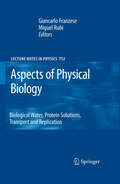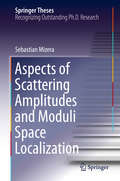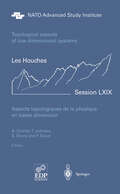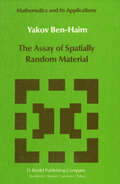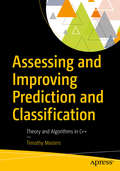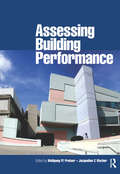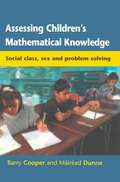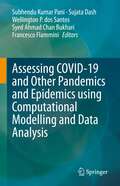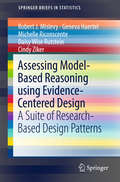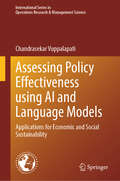- Table View
- List View
Aspects of Mathematical Logic: Lectures given at a Summer School of the Centro Internazionale Matematico Estivo (C.I.M.E.) held in Varenna (Como), Italy, September 9-17, 1968 (C.I.M.E. Summer Schools #48)
by E. CasariH. Hermes: Basic notions and applications of the theory of decidability.- D. Kurepa: On several continuum hypotheses.- A. Mostowski: Models of set theory.- A. Robinson: Problems and methods of model theory.- S. Sochor, B. Balcar: The general theory of semisets. Syntactic models of the set theory.
Aspects of Mathematical Modelling: Applications in Science, Medicine, Economics and Management (Mathematics and Biosciences in Interaction)
by Roger J. Hosking Ezio VenturinoThe construction of mathematical models is an essential scientific activity. Mathematics is associated with developments in science and engineering, but more recently mathematical modelling has been used to investigate complex systems that arise in other fields. This book demonstrates the application of mathematics to research topics in ecology and environmental science, health and medicine, phylogenetics and neural networks, theoretical chemistry, economics and management.
Aspects of Molecular Computing: Essays Dedicated to Tom Head on the Occasion of His 70th Birthday (Lecture Notes in Computer Science #2950)
by Natasha Jonoska Gheorghe P 259 Un Grzegorz RozenbergMolecular computing is a rapidly growing subarea of natural computing. On the one hand, molecular computing is concerned with the use of bio-molecules for the purpose of actual computations while, on the other hand, it attempts to understand the computational nature of molecular processes going on in living cells. The book presents a unique and authorative state-of-the-art survey on current research in molecular computing: 30 papers by leading researchers in the area are drawn together on the occasion of the 70th birthday of Tom Head, a pioneer in molecular computing. Among the topics addressed are molecular tiling, DNA self-assembly, splicing systems, DNA-based cryptography, DNA word design, gene assembly, and membrane computing.
Aspects of Multivariate Statistical Theory (Wiley Series in Probability and Statistics #197)
by Robb J. MuirheadThe Wiley-Interscience Paperback Series consists of selected books that have been made more accessible to consumers in an effort to increase global appeal and general circulation. With these new unabridged softcover volumes, Wiley hopes to extend the lives of these works by making them available to future generations of statisticians, mathematicians, and scientists. ". . . the wealth of material on statistics concerning the multivariate normal distribution is quite exceptional. As such it is a very useful source of information for the general statistician and a must for anyone wanting to penetrate deeper into the multivariate field." -Mededelingen van het Wiskundig Genootschap "This book is a comprehensive and clearly written text on multivariate analysis from a theoretical point of view." -The Statistician Aspects of Multivariate Statistical Theory presents a classical mathematical treatment of the techniques, distributions, and inferences based on multivariate normal distribution. Noncentral distribution theory, decision theoretic estimation of the parameters of a multivariate normal distribution, and the uses of spherical and elliptical distributions in multivariate analysis are introduced. Advances in multivariate analysis are discussed, including decision theory and robustness. The book also includes tables of percentage points of many of the standard likelihood statistics used in multivariate statistical procedures. This definitive resource provides in-depth discussion of the multivariate field and serves admirably as both a textbook and reference.
Aspects of Natural Language Processing: Essays Dedicated to Leonard Bolc on the Occasion of His 75th Birthday (Lecture Notes in Computer Science #5070)
by Malgorzata Marciniak Agnieszka MykowieckaFor many years Leonard Bolc has played an important role in the Polish computer science community. He is especially known for his clear vision in the development of artificial intelligence, inspiring research, organizational and editorial achievements in areas such as e.g.: logic, automatic reasoning, natural language processing, and computer applications of natural language or human-like reasoning. This Festschrift volume, published to honor Leonard Bolc on his 75th birthday includes 17 refereed papers by leading researchers, his friends, former students and colleagues to celebrate his scientific career. The essays present research in the areas which Leonard Bolc and his colleagues investigated during his long scientific career. The volume is organized in three parts; the first is devoted to logic - the domain which was one of the most explored by Leonard Bolc himself. The second part contains papers focusing on different aspects of computational linguistics; the third part comprises papers describing different applications in which natural language processing or automatic reasoning plays an important role.
Aspects of Physical Biology: Biological Water, Protein Solutions, Transport and Replication (Lecture Notes in Physics #752)
by Giancarlo Franzese Miguel RubiThe application to Biology of the methodologies developed in Physics is attracting an increasing interest from the scientific community. It has led to the emergence of a new interdisciplinary field, called Physical Biology, with the aim of reaching a better understanding of the biological mechanisms at molecular and cellular levels. Statistical Mechanics in particular plays an important role in the development of this new field. For this reason, the XXth session of the famous Sitges Conference on Statistical Physics was dedicated to "Physical Biology: from Molecular Interactions to Cellular Behavior". As is by now tradition, a number of lectures were subsequently selected, expanded and updated for publication as lecture notes, so as to provide both a state-of-the-art introduction and overview to a number of subjects of broader interest and to favor the interchange and cross-fertilization of ideas between biologists and physicists. The present volume focuses on three main subtopics (biological water, protein solutions as well as transport and replication), presenting for each of them the on-going debates on recent results. The role of water in biological processes, the mechanisms of protein folding, the phases and cooperative effects in biological solutions, the thermodynamic description of replication, transport and neural activity, all are subjects that are revised in this volume, based on new experiments and new theoretical interpretations.
Aspects of Risk Theory (Springer Series in Statistics)
by Jan GrandellRisk theory, which deals with stochastic models of an insurance business, is a classical application of probability theory. The fundamental problem in risk theory is to investigate the ruin possibility of the risk business. Traditionally the occurrence of the claims is described by a Poisson process and the cost of the claims by a sequence of random variables. This book is a treatise of risk theory with emphasis on models where the occurrence of the claims is described by more general point processes than the Poisson process, such as renewal processes, Cox processes and general stationary point processes. In the Cox case the possibility of risk fluctuation is explicitly taken into account. The presentation is based on modern probabilistic methods rather than on analytic methods. The theory is accompanied with discussions on practical evaluation of ruin probabilities and statistical estimation. Many numerical illustrations of the results are given.
Aspects of Scattering Amplitudes and Moduli Space Localization (Springer Theses)
by Sebastian MizeraThis thesis proposes a new perspective on scattering amplitudes in quantum field theories. Their standard formulation in terms of sums over Feynman diagrams is replaced by a computation of geometric invariants, called intersection numbers, on moduli spaces of Riemann surfaces. It therefore gives a physical interpretation of intersection numbers, which have been extensively studied in the mathematics literature in the context of generalized hypergeometric functions. This book explores physical consequences of this formulation, such as recursion relations, connections to geometry and string theory, as well as a phenomenon called moduli space localization. After reviewing necessary mathematical background, including topology of moduli spaces of Riemann spheres with punctures and its fundamental group, the definition and properties of intersection numbers are presented. A comprehensive list of applications and relations to other objects is given, including those to scattering amplitudes in open- and closed-string theories. The highlights of the thesis are the results regarding localization properties of intersection numbers in two opposite limits: in the low- and the high-energy expansion. In order to facilitate efficient computations of intersection numbers the author introduces recursion relations that exploit fibration properties of the moduli space. These are formulated in terms of so-called braid matrices that encode the information of how points braid around each other on the corresponding Riemann surface. Numerous application of this approach are presented for computation of scattering amplitudes in various gauge and gravity theories. This book comes with an extensive appendix that gives a pedagogical introduction to the topic of homologies with coefficients in a local system.
Aspects of Semidefinite Programming: Interior Point Algorithms and Selected Applications (Applied Optimization #65)
by E. de KlerkSemidefinite programming has been described as linear programming for the year 2000. It is an exciting new branch of mathematical programming, due to important applications in control theory, combinatorial optimization and other fields. Moreover, the successful interior point algorithms for linear programming can be extended to semidefinite programming.In this monograph the basic theory of interior point algorithms is explained. This includes the latest results on the properties of the central path as well as the analysis of the most important classes of algorithms. Several "classic" applications of semidefinite programming are also described in detail. These include the Lovász theta function and the MAX-CUT approximation algorithm by Goemans and Williamson. Audience: Researchers or graduate students in optimization or related fields, who wish to learn more about the theory and applications of semidefinite programming.
Aspects of Statistical Inference (Wiley Series in Probability and Statistics #916)
by A. H. WelshRelevant, concrete, and thorough--the essential data-based text onstatistical inference The ability to formulate abstract concepts and draw conclusionsfrom data is fundamental to mastering statistics. Aspects ofStatistical Inference equips advanced undergraduate and graduatestudents with a comprehensive grounding in statistical inference,including nonstandard topics such as robustness, randomization, andfinite population inference. A. H. Welsh goes beyond the standard texts and expertly synthesizesbroad, critical theory with concrete data and relevant topics. Thetext follows a historical framework, uses real-data sets andstatistical graphics, and treats multiparameter problems, yet isultimately about the concepts themselves. Written with clarity and depth, Aspects of Statistical Inference: * Provides a theoretical and historical grounding in statisticalinference that considers Bayesian, fiducial, likelihood, andfrequentist approaches * Illustrates methods with real-data sets on diabetic retinopathy,the pharmacological effects of caffeine, stellar velocity, andindustrial experiments * Considers multiparameter problems * Develops large sample approximations and shows how to use them * Presents the philosophy and application of robustness theory * Highlights the central role of randomization in statistics * Uses simple proofs to illuminate foundational concepts * Contains an appendix of useful facts concerning expansions,matrices, integrals, and distribution theory Here is the ultimate data-based text for comparing and presentingthe latest approaches to statistical inference.
Aspects of the Computer-based Patient Record (Health Informatics)
by Morris F. Collen Marion J. BallOne of the hottest political issues today concerns ways to improve national healthcare systems without incurring further costs. An extensive study by the Institute of Medicine (IOM) in the United States formally reported that computer-based patient records are absolutely necessary to help contain the cost explosion in health care. The information obtained from experts, the studies conducted, and the conclusions that went into the IOM's report have now been collected in Aspects of the Computer-Based Patient Record. A large portion of the volume discusses the state-of-the-art in existing computer-based systems as well as the essential needs which must be addressed by future computer-based patients' records. A final section in the book discusses implementation strategies for changing to the electronic system and practical issues: Who will bear the final cost? How and when will healthcare providers who use the system be trained? This volume contains the concise, valuable information which hospital administrators, hospital systems designers, third-party payer groups, and medical technology providers will need if they hope to successfully transit to hospital systems which use a computer-based patient record.
Aspects topologiques de la physique en basse dimension. Topological aspects of low dimensional systems (Les Houches - Ecole d'Ete de Physique Theorique #69)
by A. Comtet T. Jolicoeur S. Ouvry F. DavidSession LXIX. 7 - 31 July 1998
Aspekte des Unendlichen: Eine kleine Erzählung für Nichtmathematiker (Die blaue Stunde der Informatik)
by Lutz PrieseEin Buch über die Unendlichkeit Wer glaubt, dass sich Rechnen auf trockene Formeln und Zahlen beschränkt, wird mit „Aspekte des Unendlichen – Eine kleine Erzählung für Nichtmathematiker“ sein blaues Wunder erleben. Dieses Buch spricht alle Leser an, die nicht nur die Logik, sondern auch die Poesie der Unendlichkeit erforschen möchten. Anstatt Laien mit kryptischem Akademikerjargon zu verwirren, übersetzt es komplexe Sachverhalte in leicht verständliche Erklärungen. So können auch Einsteiger erfahren, welche Überraschungen die Mengenlehre bereithält. Von nicht abzählbaren Größen und unentscheidbaren Fragen Die Wissenschaft der mathematischen Unendlichkeit umfasst zahlreiche Problemstellungen, die ebenso anspruchsvoll wie spannend sind. Dazu gehören unter anderem:· die Bibliothek von Babel· diskontinuierliche Kontinua· Unmengen· Paradoxien und Antinomien Um solche theoretischen Ansätze in ihren Grundzügen zu begreifen, braucht es keinen Hochschulabschluss. Lutz Prieses Buch über die Mathematik der Unendlichkeit verwandelt abstrakte Konzepte in lebensnahe Zusammenhänge. Der Autor ist promovierter Logiker und hält seit seiner Pensionierung regelmäßig Vorlesungen zu Themen der Mathematik und Informatik. Dank seiner langjährigen Tätigkeit als Hochschuldozent gelingt es ihm, mit einer unterhaltsamen Sprache Anfänger und Experten gleichermaßen zu fesseln. Dabei steht vor allem die Verbindung zwischen mathematischen und philosophischen Problemen im Vordergrund:· Wie genau können wir mit Zahlen die unendlichen Weiten des Weltalls erfassen?· Inwiefern spiegeln die Grenzen des Rechnens die Grenzen des menschlichen Daseins wider?· Wie können wir Unvorstellbares vorstellbar machen? Prieses Buch über die Unendlichkeit in der Mathematik liefert keine endgültigen Antworten auf diese Fragen. Vielmehr regt es Leser dazu an, sich selbst auf die Suche zu machen und eigene Ideen zu entwickeln. Wie es der Titel verspricht, lädt „Aspekte des Unendlichen“ zu einer schier endlosen Reise durch die Gedankenwelt ein.
The Assamese: Religion, Caste and Sect in an Indian Village (Routledge Revivals)
by Audrey CantlieFirst published in 1984, The Assamese is an anthropological exploration of Assam. The many tribes living in the hill tracts of Assam early engaged the attention of anthropologists but no significant studies have been made of the people living in the Assam valley who call themselves Assamese, the distinctive features of whose culture are inseparably connected with their religious institutions. The purpose of this book is to give an account of the way of life which the Assamese people are seeking to preserve, and its chief claim to attention is that it is the very first field-study of the village foundations of social life in Assam, containing a plenitude of detailed information on local aggregates, caste divisions, modes of livelihood, devotional practices, marriage patterns, and much else. This book will be of interest to students of anthropology, ethnic studies, history and cultural studies.
The Assamese: Religion, Caste and Sect in an Indian Village (Routledge Revivals)
by Audrey CantlieFirst published in 1984, The Assamese is an anthropological exploration of Assam. The many tribes living in the hill tracts of Assam early engaged the attention of anthropologists but no significant studies have been made of the people living in the Assam valley who call themselves Assamese, the distinctive features of whose culture are inseparably connected with their religious institutions. The purpose of this book is to give an account of the way of life which the Assamese people are seeking to preserve, and its chief claim to attention is that it is the very first field-study of the village foundations of social life in Assam, containing a plenitude of detailed information on local aggregates, caste divisions, modes of livelihood, devotional practices, marriage patterns, and much else. This book will be of interest to students of anthropology, ethnic studies, history and cultural studies.
The Assay of Spatially Random Material (Mathematics and Its Applications #20)
by Yakov Ben-HaimApproach your problems from the right end It isn't that they can't see the solution. It is and begin with the answers. Then one day, that they can't see the problem. perhaps you will find the final question. G. K. Chesterton. The Scandal of Father 'The Hermit Clad in Crane Feathers' in R. Brown The point of a Pin'. van Gulik's The Chinese Maze Murders. Growing specialization and diversification have brought a host of monographs and textbooks on increasingly specialized topics. However, the "tree" of knowledge of mathematics and related fields does not grow only by putting forth new branches. It also happens, quite often in fact, that branches which were thought to be completely disparate are suddenly seen to be related. Further, the kind and level of sophistication of mathematics applied in various sciences has changed drastically in recent years: measure theory is used (non trivially) in regional and theoretical economics; algebraic geometry interacts with physics; the Minkowsky lemma, coding theory and the structure of water meet one another in packing and covering theory; quantum fields, crystal defects and mathematical programming profit from homotopy theory; Lie algebras are relevant to filtering; and prediction and electrical engineering can use Stein spaces. And in addition to this there are such new emerging subdisciplines as "experimental mathematics", "CFD", "completely integrable systems", "chaos, synergetics and large-scale order", which are almost impossible to fit into the existing classification schemes. They draw upon widely different sections of mathematics.
Assembly Line Balancing under Uncertain Task Time and Demand Volatility (Engineering Applications of Computational Methods #8)
by Yuchen LiThis book introduces several mathematical models in assembly line balancing based on stochastic programming and develops exact and heuristic methods to solve them. An assembly line system is a manufacturing process in which parts are added in sequence from workstation to workstation until the final assembly is produced. In an assembly line balancing problem, tasks belonging to different product models are allocated to workstations according to their processing times and precedence relationships among tasks. It incorporates two features, uncertain task times, and demand volatility, separately and simultaneously, into the conventional assembly line balancing model. A real-life case study related to the mask production during the COVID-19 pandemic is presented to illustrate the application of the proposed framework and methodology. The book is intended for graduate students who are interested in combinatorial optimizations in manufacturing with uncertain input.
Assessing and Improving Prediction and Classification: Theory and Algorithms in C++
by Timothy MastersAssess the quality of your prediction and classification models in ways that accurately reflect their real-world performance, and then improve this performance using state-of-the-art algorithms such as committee-based decision making, resampling the dataset, and boosting. This book presents many important techniques for building powerful, robust models and quantifying their expected behavior when put to work in your application.Considerable attention is given to information theory, especially as it relates to discovering and exploiting relationships between variables employed by your models. This presentation of an often confusing subject avoids advanced mathematics, focusing instead on concepts easily understood by those with modest background in mathematics.All algorithms include an intuitive explanation of operation, essential equations, references to more rigorous theory, and commented C++ source code. Many of these techniques are recent developments, still not in widespread use. Others are standard algorithms given a fresh look. In every case, the emphasis is on practical applicability, with all code written in such a way that it can easily be included in any program.What You'll LearnCompute entropy to detect problematic predictorsImprove numeric predictions using constrained and unconstrained combinations, variance-weighted interpolation, and kernel-regression smoothingCarry out classification decisions using Borda counts, MinMax and MaxMin rules, union and intersection rules, logistic regression, selection by local accuracy, maximization of the fuzzy integral, and pairwise couplingHarness information-theoretic techniques to rapidly screen large numbers of candidate predictors, identifying those that are especially promisingUse Monte-Carlo permutation methods to assess the role of good luck in performance resultsCompute confidence and tolerance intervals for predictions, as well as confidence levels for classification decisionsWho This Book is ForAnyone who creates prediction or classification models will find a wealth of useful algorithms in this book. Although all code examples are written in C++, the algorithms are described in sufficient detail that they can easily be programmed in any language.
Assessing Building Performance
by Wolfgang Preiser Jacqueline VischerThe building performance evaluation (BPE) framework emphasizes an evaluative stance throughout the six phases of the building delivery and life cycle: (1) strategic planning/needs analysis; (2) program review; (3) design review; (4) post-construction evaluation/review; (5) post-occupancy evaluation; and, (6) facilities management review/adaptive reuse.The lessons learned from positive and negative building performance are fed into future building delivery cycles. The case studies illustrate how this basic methodology has been adapted to a range of cultural contexts, and indicates the positive results of building performance assessment in a wide range of situations.
Assessing Building Performance
by Wolfgang F.E. Preiser Jacqueline C. VischerThe building performance evaluation (BPE) framework emphasizes an evaluative stance throughout the six phases of the building delivery and life cycle: (1) strategic planning/needs analysis; (2) program review; (3) design review; (4) post-construction evaluation/review; (5) post-occupancy evaluation; and, (6) facilities management review/adaptive reuse.The lessons learned from positive and negative building performance are fed into future building delivery cycles. The case studies illustrate how this basic methodology has been adapted to a range of cultural contexts, and indicates the positive results of building performance assessment in a wide range of situations.
Assessing Children's Mathematical Knowledge (UK Higher Education OUP Humanities & Social Sciences Education OUP)
by Barry Cooper Mairead Dunne'this work is highly relevant to the proliferation of accountability measures worldwide'James Scheurich and Douglas FoleyIn many countries, the lives of teachers and children are increasingly dominated by programmes of national testing of mathematics and other subjects. In England, the majority of the items in such tests have set mathematical tasks in every day situations such as 'shopping'. This requires children to make decisions about whether to use or not their own every day knowledge and experience in their problem-solving. Some children are likely to have a better 'feel for this game' than others. Assessing Children's Mathematical Knowledge draws on the analysis of national curriculum test data from more than 600 children of 10-11 and 13-14 years of age, as well as in-depth interviews with 250 of these as they attempt to solve test problems, in order to explore the nature of the difficulties children experience with 'realistic' items. The book shows, by comparing test and interview data, that many children, as a consequence of their confusion over the requirements of 'realistic' test items, fail in tests to demonstrate mathematical knowledge and understanding that they actually possess. The book also explores whether this problem of invalid measurement is equally spread across children from different social backgrounds, and across the sexes.The book will be of interest to academics and teachers studying for advanced degrees in mathematics education, sociology of education and educational assessment.
Assessing COVID-19 and Other Pandemics and Epidemics using Computational Modelling and Data Analysis
by Subhendu Kumar Pani Sujata Dash Wellington P. dos Santos Syed Ahmad Chan Bukhari Francesco FlamminiThis book comprehensively covers the topic of COVID-19 and other pandemics and epidemics data analytics using computational modelling. Biomedical and Health Informatics is an emerging field of research at the intersection of information science, computer science, and health care. The new era of pandemics and epidemics bring tremendous opportunities and challenges due to the plentiful and easily available medical data allowing for further analysis. The aim of pandemics and epidemics research is to ensure high-quality, efficient healthcare, better treatment and quality of life by efficiently analyzing the abundant medical, and healthcare data including patient’s data, electronic health records (EHRs) and lifestyle. In the past, it was a common requirement to have domain experts for developing models for biomedical or healthcare. However, recent advances in representation learning algorithms allow us to automatically learn the pattern and representation of the given data for the development of such models. Medical Image Mining, a novel research area (due to its large amount of medical images) are increasingly generated and stored digitally. These images are mainly in the form of: computed tomography (CT), X-ray, nuclear medicine imaging (PET, SPECT), magnetic resonance imaging (MRI) and ultrasound. Patients’ biomedical images can be digitized using data mining techniques and may help in answering several important and critical questions related to health care. Image mining in medicine can help to uncover new relationships between data and reveal new and useful information that can be helpful for scientists and biomedical practitioners. Assessing COVID-19 and Other Pandemics and Epidemics using Computational Modelling and Data Analysis will play a vital role in improving human life in response to pandemics and epidemics. The state-of-the-art approaches for data mining-based medical and health related applications will be of great value to researchers and practitioners working in biomedical, health informatics, and artificial intelligence..
Assessing Mathematical Literacy: The PISA Experience
by Kaye Stacey Ross TurnerThis book describes the design, development, delivery and impact of the mathematics assessment for the OECD Programme for International Student Assessment (PISA). First, the origins of PISA’s concept of mathematical literacy are discussed, highlighting the underlying themes of mathematics as preparation for life after school and mathematical modelling of the real world, and clarifying PISA’s position within this part of the mathematics education territory. The PISA mathematics framework is introduced as a significant milestone in the development and dissemination of these ideas. The underlying mathematical competencies on which mathematical literacy so strongly depends are described, along with a scheme to use them in item creation and analysis. The development and implementation of the PISA survey and the consequences for the outcomes are thoroughly discussed. Different kinds of items for both paper-based and computer-based PISA surveys are exemplified by many publicly released items along with details of scoring. The novel survey of the opportunity students have had to learn the mathematics promoted through PISA is explained. The book concludes by surveying international impact. It presents viewpoints of mathematics educators on how PISA and its constituent ideas and methods have influenced teaching and learning practices, curriculum arrangements, assessment practices, and the educational debate more generally in fourteen countries.
Assessing Model-Based Reasoning using Evidence- Centered Design: A Suite of Research-Based Design Patterns (SpringerBriefs in Statistics)
by Robert J Mislevy Geneva Haertel Michelle Riconscente Daisy Wise Rutstein Cindy ZikerThis Springer Brief provides theory, practical guidance, and support tools to help designers create complex, valid assessment tasks for hard-to-measure, yet crucial, science education standards. Understanding, exploring, and interacting with the world through models characterizes science in all its branches and at all levels of education. Model-based reasoning is central to science education and thus science assessment. Current interest in developing and using models has increased with the release of the Next Generation Science Standards, which identified this as one of the eight practices of science and engineering. However, the interactive, complex, and often technology-based tasks that are needed to assess model-based reasoning in its fullest forms are difficult to develop. Building on research in assessment, science education, and learning science, this Brief describes a suite of design patterns that can help assessment designers, researchers, and teachers create tasks for assessing aspects of model-based reasoning: Model Formation, Model Use, Model Elaboration, Model Articulation, Model Evaluation, Model Revision, and Model-Based Inquiry. Each design pattern lays out considerations concerning targeted knowledge and ways of capturing and evaluating students’ work. These design patterns are available at http://design-drk.padi.sri.com/padi/do/NodeAction?state=listNodes&NODE_TYPE=PARADIGM_TYPE. The ideas are illustrated with examples from existing assessments and the research literature.
Assessing Policy Effectiveness using AI and Language Models: Applications for Economic and Social Sustainability (International Series in Operations Research & Management Science #354)
by Chandrasekar VuppalapatiThis volume uses advanced machine learning techniques to analyze government communication to evaluate policy effectiveness. The book develops policy effectiveness foundation models by cohorting historical budget policies with statistical models which are built on well reputed data sources including economic events, macroeconomic trends, and ratings and commerce terms from international institutions. By signal mining policies to the economic outcome patterns, the book aims to create a rich source of successful policy insights in terms of their effectiveness in bringing development to the poor and underserved communities to ensure the spread of wealth, social wellbeing, and standard of living to the common denomination of society rather than a selected quotient. Enabling academics and practitioners across disciplines to develop applications for effective policy interventions, this volume will be of interest to a wide audience including software engineers, data scientists, social scientists, economists, and agriculture practitioners.





